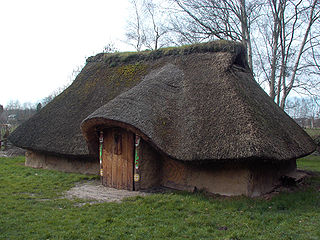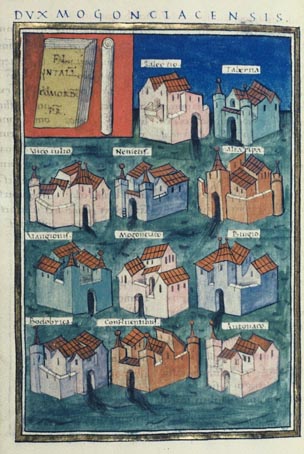Related Research Articles

The Batavi were an ancient Germanic tribe that lived around the modern Dutch Rhine delta in the area that the Romans called Batavia, from the second half of the first century BC to the third century AD. The name is also applied to several military units employed by the Romans that were originally raised among the Batavi. The tribal name, probably a derivation from batawjō, refers to the region's fertility, today known as the fruitbasket of the Netherlands.

Germania, also called Magna Germania, Germania Libera, or Germanic Barbaricum to distinguish it from the Roman province of the same name, was a historical region in north-central Europe during the Roman era, which was associated by Roman authors with the Germanic peoples. The region stretched roughly from the Middle and Lower Rhine in the west to the Vistula in the east. It also extended at some point as far south as the Upper and Middle Danube and Pannonia, and to the known parts of southern Scandinavia in the north. Archaeologically, these peoples correspond roughly to the Roman Iron Age of those regions. While dominated by Germanic peoples, Magna Germania was also inhabited by few other Indo-European peoples.

The Ubii were a Germanic tribe first encountered dwelling on the east bank of the Rhine in the time of Julius Caesar, who formed an alliance with them in 55 BC in order to launch attacks across the river. They were transported in 39 BC by Marcus Vipsanius Agrippa to the west bank, apparently at their own request, as they feared the incursions of their neighbors, the Chatti.

The Revolt of the Batavi took place in the Roman province of Germania Inferior between AD 69 and 70. It was an uprising against the Roman Empire started by the Batavi, a small but militarily powerful Germanic tribe that inhabited Batavia, on the delta of the river Rhine. They were soon joined by the Celtic tribes from Gallia Belgica and some Germanic tribes.

Germania Inferior was a Roman province from AD 85 until the province was renamed Germania Secunda in the 4th century AD, on the west bank of the Rhine bordering the North Sea. The capital of the province was Colonia Claudia Ara Agrippinensium.

Gallia Belgica was a province of the Roman Empire located in the north-eastern part of Roman Gaul, in what is today primarily northern France, Belgium, and Luxembourg, along with parts of the Netherlands and Germany.

The Menapii were a Belgic tribe dwelling near the North Sea, around present-day Cassel, during the Iron Age and the Roman period.

The Tungri were a tribe, or group of tribes, who lived in the Belgic part of Gaul, during the times of the Roman Empire. Within the Roman Empire, their territory was called the Civitas Tungrorum. They were described by Tacitus as being the same people who were first called "Germani" (Germanic), meaning that all other tribes who were later referred to this way, including those in Germania east of the river Rhine, were named after them. More specifically, Tacitus was thereby equating the Tungri with the "Germani Cisrhenani" described generations earlier by Julius Caesar. Their name is the source of several place names in Belgium, Germany and the Netherlands, including Tongeren, Tongerlo Abbey, and Tongelre.

Ripuarian or Rhineland Franks were one of the two main groupings of early Frankish people, and specifically it was the name eventually applied to the tribes who settled in the old Roman territory of the Ubii, with its capital at Cologne on the Rhine river in modern Germany. Their western neighbours were the Salii, or "Salian Franks", who were named already in late Roman records, and settled with imperial permission within the Roman Empire in what is today the southern part of the Netherlands, and Belgium, and later expanded their influence into the northern part of France north of the Loire river, creating the Frankish empire of Francia.

The Vangiones appear first in history as an ancient Germanic tribe of unknown provenance. They threw in their lot with Ariovistus in his bid of 58 BC to invade Gaul through the Doubs river valley and lost to Julius Caesar in a battle probably near Belfort. After some Celts evacuated the region in fear of the Suebi, the Vangiones, who had made a Roman peace, were allowed to settle among the Mediomatrici in northern Alsace.. They gradually assumed control of the Celtic city of Burbetomagus, later Worms.
The Texandri were a Germanic people living between the Scheldt and Rhine rivers in the 1st century AD. They are associated with a region mentioned in the late 4th century as Texandria, a name which survived into the 8th–12th centuries.
The Frisiavones were a Germanic people living near the northern border of Gallia Belgica during the early first millennium AD. Little is known about them, but they appear to have resided in the area of what is today the southern Netherlands, possibly in two distinct regions, one in the islands of the river deltas of Holland, and one to the southeast of it.

Colonia Claudia Ara Agrippinensium was the Roman colony in the Rhineland from which the city of Cologne, now in Germany, developed.

For around 450 years, from around 55 BC to around 410 AD, the southern part of the Netherlands was integrated into the Roman Empire. During this time the Romans in the Netherlands had an enormous influence on the lives and culture of the people who lived in the Netherlands at the time and (indirectly) on the generations that followed.

North Rhine-Westphalia was established by the British military administration's "Operation Marriage" on 23 August 1946 by merging the Rhine Province with the Province of Westphalia. On 21 January 1947, the former Free State of Lippe was merged with North Rhine-Westphalia.
The Sunuci was the name of a tribal grouping with a particular territory within the Roman province of Germania Inferior, which later became Germania Secunda. Within this province, they were in the Civitas Agrippinenses, with its capital at Cologne. They are thought to have been a Germanic tribe, speaking a Germanic language, although they may also have had a mixed ancestry. They lived between the Meuse and Rur rivers in Roman imperial times. In modern terms this was probably in the part of Germany near Aachen, Jülich, Eschweiler and Düren, and the neighbouring areas in the southern Netherlands, around Valkenburg, and eastern Belgium, in part of the old Duchy of Limburg. There is a town just over the Belgian border from Aachen called Sinnich, in Voeren, which may owe its name to them. In other words, they lived just north of the modern northern limits of Romance languages derived from Latin.
The Baetasii were a Germanic tribal grouping within the Roman province of Germania Inferior, which later became Germania Secunda. Their exact location is still unknown, although two proposals are, first, that it might be the source of the name of the Belgian village of Geetbets, and second, that it might be further east, nearer to the Sunuci with whom they interacted in the Batavian revolt, and to the Cugerni who lived at Xanten. The area of Gennep, Goch and Geldern has been proposed for example.
The Germani cisrhenani, or "Left bank Germani", were a group of Germanic peoples who lived west of the Lower Rhine at the time of the Gallic Wars in the mid-1st century BC.

The Civitas Tungrorum was a large Roman administrative district dominating what is now eastern Belgium and the southern Netherlands. In the early days of the Roman Empire it was in the province of Gallia Belgica, but it later joined the neighbouring lower Rhine River border districts, within the province of Germania Inferior. Its capital was Aduatuca Tungrorum, now Tongeren.
Hercules Magusanus is a Romano-Germanic deity or hero worshipped during the early first millennium AD in the Lower Rhine region among the Batavi, Marsaci, Ubii, Cugerni, Baetasii, and probably among the Tungri.
References
- ↑ Derks, Ton (2009), "Ethnic Identity in the Roman Frontier: The Epigraphy of the Batavi and the other Lower Rhine tribes", in Derks, Ton; Roymans, Nico (eds.), Ethnic constructs in antiquity: the role of power and tradition, Amsterdam University Press, ISBN 9789089640789
- 1 2 3 Byvanck (1943), Nederland in Den Romeinschen Tijd, Brill
- ↑ Neumann 1999, pp. 112–113.
Bibliography
- Neumann, Günter (1999), "Germani cisrhenani — die Aussage der Namen", in Beck, H.; Geuenich, D.; Steuer, H. (eds.), Germanenprobleme in heutiger Sicht, Walter de Gruyter, ISBN 978-3110164381
